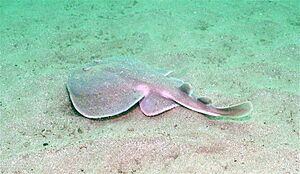Apron ray facts for kids
Quick facts for kids Apron ray |
|
|---|---|
 |
|
| Conservation status | |
| Scientific classification | |
| Synonyms | |
|
Torpedo chilensis Guichenot, 1848 |
The apron ray (Discopyge tschudii) is a small electric ray. It belongs to the numbfish family, called Narcinidae. This ray is special because it can make electric shocks. It uses these shocks to protect itself from danger. The apron ray is one of only two kinds of rays in its group, Discopyge.
Contents
Where Apron Rays Live
The apron ray is a fish that lives in cold ocean waters. You can find it off the coast of South America, south of a certain line on the map (33°S latitude).
It lives in two main areas:
- The southwest Atlantic Ocean, near Uruguay and Argentina. A few even go into southern Brazil during winter.
- The southeast Pacific Ocean, along the coasts of Chile and Peru.
Scientists think the groups in the Atlantic and Pacific oceans don't mix. This is because the Atlantic group doesn't go further south than northern Argentina. These rays usually live on the continental shelf, which is the shallow part of the ocean floor near land. They prefer areas with a sandy bottom. They can be found at depths from about 72 to 594 feet (22 to 181 meters).
What Apron Rays Look Like
The apron ray looks a lot like another type of ray called Narcine. It has a round body shape, like a disc. It also has two fins on its back and a strong tail with folds on the sides.
A special thing about the apron ray is its pelvic fins. These are the fins on its belly. They are joined together under its tail, making a single, flat shape. The biggest apron ray ever found was a male, about 21 inches (54 cm) long. Female apron rays are ready to have babies when they are about 11 inches (27.5 cm) long. Males are ready when they are between 14 and 18 inches (35 to 46 cm) long.
Apron Ray Life and Habits
Apron rays are fish that live on the ocean floor. They are known to be social and like to live in groups. Scientists have studied what apron rays eat. They found that about 90% of their diet comes from the tips of tubes (called siphons) from a type of clam. This clam is named Amiantis purpurata.
Smaller rays eat smaller clam siphons, and larger rays eat larger ones. Male rays tend to nip off longer pieces of siphon than females. Other studies show that apron rays also eat polychaete worms and small shrimp-like creatures called amphipods.
Apron rays are ovoviviparous. This means their eggs hatch inside the mother's body. The babies then come out alive. A mother ray can have anywhere from 1 to 12 pups at a time. However, having 4 or 5 pups is most common. The baby rays are usually about 3.3 to 3.6 inches (8.5 to 9.2 cm) long when they are born.
Protecting the Apron Ray
Apron rays are sometimes caught by accident. This happens during bottom trawl fisheries, where large nets are dragged along the ocean floor. When caught this way, they are called by-catch. Apron rays don't have much value for selling. So, they are often thrown back into the ocean or used to make fish meal.
Research in areas like Buenos Aires Province and Uruguay showed a big drop in apron ray numbers from 1994 to 1999. Their numbers went down by 88%. But during this time, the rays also moved to different areas. So, it's not clear if the decline was only because of more fishing. Around the world, the apron ray is currently listed as "least concern." This means it's not in immediate danger of disappearing.
Apron rays, like other electric rays, are very important for science. Scientists use them to study how our nerves work. This is because the electric organs of these rays have many special cells. These cells help scientists understand how signals are sent between nerve cells in our bodies.


